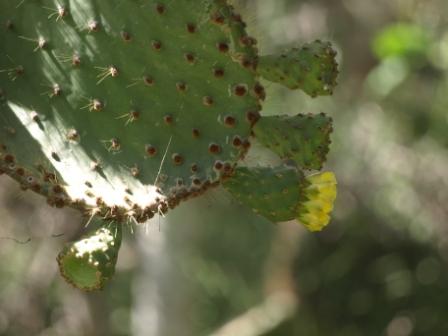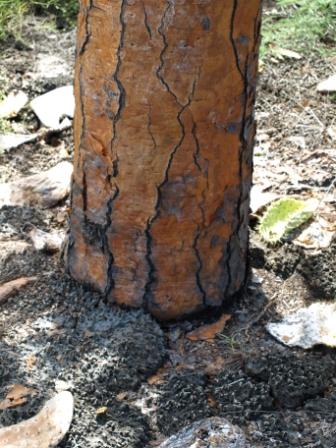Cactus trees (!)

Not only the animals here are amazing - so are the plants.
Opuntia cacti (prickly pears) are common elsewhere, but only here do they grow into trees. Not real trees - being cacti they have no wood and support themelveswith fibre instead - but here, trees they are nonetheless as far as an ecological niche is concerned. And they're all trees - there are no 'normal' sessile types, and all the species here are endemic. Just like the animals they arrived here once, and then diversified into several different types which are recognised scientifically as species, subspecies or types (this concept of speciation is even more fraught with difficulty in botany than it is in zoology). This process is still used by the term 'adaptive radiation' invented by Darwin in his 'On The Origin Of Species' (1859) about which more (of course) in a later Blog - a small measure of the vast importance of his thinking even now.
Anyway, here are some Galapagos prickly pears;

At this range they look exactly like Opuntia fruits elsewhere: a large yellow flower which last for one day only, and a prickly seed capsule a little smaller than a domestic pear. The fruit is edible (it is sold commercially in the Canary Islands, where gloves are placed by the display to protect the customers from the very painful and irritating small spines) but not here because all the local species are endemic and therefore strictly protected.
The fruit once opened is a vivid purple colour, not at all what you might expect, and very tasty. The tortoises and land iguanas think so too - they love a nice prickly pear and have the mouths to cope with the spines which seem not to bother them at all. In fact it is this predation by tortoises that may have persuaded the opuntias here to grow into trees. in the dry season the opuntias remain stuffed with water, fruit and 'leaves' alike (as a cactus, what looks like leaves are actually flattened stems, the true leaves having become the spines) - in fact on most islands this is the reptiles only source of water. So growing upwards is a good protection stategy for the opuntias.
And this is what they've grown into:

This sort of wierd dry forest dominates some islands, and opuntias are a component of lower arid vegetation everywhere, growing in amongst otherplants and small trees. The candelabra cactus on the left is also endemic, but in this case the entire genus is endemic not just the local species. As you might expect, it too has also undergone adaptive radiation here.
The opuntias grow straight out of the bare lava, looking a bit like an elephants foot when they're older:

The older trunks are bare, and impossible for an iguana to climb. When younger and more climbable they are covered in long sharp spines to dissuade marauding reptiles from even attempting it!
The roots are very susceptible to waterlogging which kills the tree, so wet 'El Nino' years cause very significant die back and then significant vegetation structural changes - the islands have not yet recovered from the devastating 1983 El Nino.